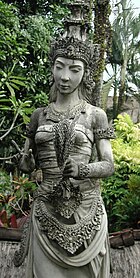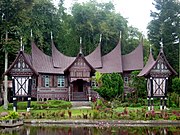Culture of Indonesia
From Wikipedia, the free encyclopedia

Indonesian culture has been shaped by long interaction between original indigenous customs and multiple foreign influences. Indonesia is central along ancient trading routes between the Far East and the Middle East, resulting in many cultural practices being strongly influenced by a multitude of religions, including Hinduism, Buddhism, Confucianism and Islam, all strong in the major trading cities. The result is a complex cultural mixture very different from the original indigenous cultures.
Examples of cultural fusion include the fusion of Islam with Hindu in Javanese Abangan belief, the fusion of Hinduism, Buddhism and animism in Bodha, and the fusion of Hinduism and animism in Kaharingan; others could be cited.
Indonesian art-forms express this cultural mix. Wayang, traditional theater-performed puppet shows, were a medium in the spread of Hinduism and Islam amongst Javan villagers. Both Javanese and Balinese dances have stories about ancient Buddhist and Hindu kingdoms, while Islamic art forms and architecture are present in Sumatra, especially in the Minangkabau and Aceh regions. Traditional art, music and sport are combined in a martial art form called Pencak Silat.
Western culture has influenced Indonesia most in modern entertainment such as television shows, movies and songs. India has notably influenced Indonesian songs and movies. A popular type of song is the Indian-rhythmical dangdut, which is often mixed with Arab and Malay folk music.
Despite the influences of foreign culture, some remote Indonesian regions still preserve uniquely indigenous culture. Indigenous ethnic groups of Mentawai, Asmat, Dani, Dayak, Toraja and many others are still practising their ethnic rituals, customs and wearing traditional clothes.
Contents |
[edit] Traditional performing arts
[edit] Music

Indonesia is home to hundreds of forms of music, with those from the islands of Java, Sumatra and Bali being frequently recorded. The traditional music of central and East Java and Bali is the gamelan.
In 1966, a law was passed (Panpres 11/1965) banning Western-style pop or rock music. On June 29, 1965, Koes Plus, a leading Indonesian pop group in the 1960s, 70s and 80s, was imprisoned in Glodok, West Jakarta, for playing Western-style music. [1] After the resignation of President Sukarno, with the anti-Western Partai Komunis Indonesia disbanded, the law was rescinded, and in the 1970s the Glodok prison was destroyed to be replaced with a large shopping mall. The new mall in Glodok is now the centre of recording, production and distribution of modern Indonesian pop and rock music.
Kroncong is a musical genre that uses guitars and ukuleles as the main musical instruments. This genre had its roots in Portugal and was introduced by Portuguese traders in the fifteenth century. There is a traditional Keroncong Tugu music group in North Jakarta and other traditional Keroncong music groups in Maluku, with strong Portuguese influences. This music genre was popular in the first half of the twentieth century; a contemporary form of Kroncong is called Pop Kroncong. In addition, there are regional variations such as Langgam Jawa, which is most popular in Central Java and Yogyakarta[citation needed].
The soft Sasando music from the province of East Nusa Tenggara in West Timor is completely different. Sasando uses an instrument made from a split leaf of the Lontar palm (Borassus flabellifer), which bears some resemblance to a harp.
[edit] Dance
It is not difficult to see a continuum in the traditional dances depicting episodes from the Ramayana and Mahabharata from India, ranging through Thailand, all the way to Bali. There is a marked difference, though, between the highly stylized dances of the courts of Yogyakarta and Surakarta and their popular variations. While the court dances are promoted and even performed internationally, the popular forms of dance art and drama must largely be discovered locally.
During the last few years Saman from Aceh in North Sumatra has become rather popular and is often performed on TV.
[edit] Drama and theatre
The Javanese and Balinese shadow puppet theatre shows display several mythological events; and more.
Randai is a folk theatre tradition of the Minangkabau people of West Sumatra, usually performed for traditional ceremonies and festivals. It incorporates music, singing, dance, drama and the silat martial art, with performances often based on semi-historical Minangkabau legends and storys.
[edit] Traditional visual arts
[edit] Painting
Indonesia is not generally known for paintings, aside from the intricate and expressive Balinese paintings, which often express natural scenes and themes from the traditional dances.
Other exceptions include indigenous Kenyah paint designs based on, as commonly found among Austronesian cultures, endemic natural motifs such as ferns, trees, dogs, hornbills and human figures. These are still to be found decorating the walls of Kenyah Dayak longhouses in East Kalimantan's Apo Kayan region.
Calligraphy, mostly based on the Qur'an, is often used as decoration as Islam forbids naturalistic depictions. Some foreign painters have also settled in Indonesia. Modern Indonesian painters use a wide variety of styles and themes.
[edit] Sculpture

Indonesia has a long-he Bronze and Iron Ages, but the art-form particularly flourished in the eighth to tenth centuries, both as stand-alone works of art, and also incorporated into temples.
Most notable are the hundreds of meters of relief sculpture at the temple of Borobodur in central Java. Approximately two miles of exquisite relief sculpture tell the story of the life of Buddha and illustrate his teachings. The temple was originally home to 504 statues of the seated Buddha. This site, as with others in central Java, show a clear Indian influence.
[edit] Architecture
For centuries, the most dominant influences on Indonesian architecture were Indian, although European influences have been particularly strong since the nineteenth century and modern architecture in Indonesia is international in scope.
As in much of South East Asia, traditional buildings in Indonesia are built on stilts, with the significant exceptions of Java and Bali. Notable stilt houses are those of the Dayak people in Borneo, the Rumah Gadang of the Minangkabau people in western Sumatra, the Batak people in northern Sumatra, and the Tongkonan of the Toraja people in Sulawesi. Oversized saddle roofs with large eaves, such as the homes of the Batak and the tongkonan of Toraja, are often bigger than the house they shelter. The fronts of Torajan houses are frequently decorated with buffalo horns, stacked one above another, as an indication of status. The outside walls also frequently feature decorative reliefs.

The eighth-century Borobodur temple near Yogyakarta is the largest Buddhist temple in the world, and is notable for incorporating about 160 relief panels into its structure, telling the story of the life of the Buddha. As the visitor ascends through the eight levels of the temple, the story unfolds, the final three levels simply containing stupas and statues of the Buddha. The building is said to incorporate a map of the Buddhist cosmos and is a masterful fusion of the didactic, the monumental and the serene.
The nearby ninth-century temple complex at Prambanan contains some of the best preserved examples of Hindu temple architecture in Java. The temple complex comprises eight main shrines, surrounded by 250 smaller shrines. The Indian influence on the site is clear, not only in the style of the monument, but also in the reliefs featuring scenes from the Ramayana which adorn the outer walls of the main temples, and in the votive statuary found within.
[edit] Crafts

Several Indonesian islands are famous for their batik, ikat and songket cloth. Once on the brink of disappearing, batik and later ikat found a new lease of life when former President Suharto promoted wearing batik shirts on official occasions. In addition to the traditional patterns with their special meanings, used for particular occasions, batik designs have become creative and diverse over the last few years.
[edit] Literature
Pramoedya Ananta Toer was Indonesia's most internationally celebrated author, having won the Magsaysay Award as well as being considered for the Nobel Prize in Literature. Other important figures include the late Chairil Anwar, a poet and member of the "Generation 45" group of authors who were active in the Indonesian independence movement. Tight information controls during Suharto's presidency suppressed new writing, especially because of its ability to agitate for social reform.
In the book Max Havelaar, Dutch author Multatuli criticised the Dutch treatment of the Indonesians, which gained him international attention.
Modern Indonesian authors include Seno Gumira Adjidarma, Ayu Utami, Gus tf Sakai, Eka Kurniawan, Ratih Kumala, Dee, Oka Rusmini. A few of their works have translated into other languages.
[edit] Poetry
There is a long tradition in Indonesia, particularly among ethnically Malay populations, of extemporary, interactive, oral composition of poetry. These poems are referred to as pantun.
[edit] Recreation and sports
Many traditional games are still preserved and popular in Indonesia, although western culture has influenced some parts of them. Among three hundred officially recognized Indonesian cultures, there are many kinds of traditional games: cockfighting in Bali, annual bull races in Madura, and stone jumping in Nias. Stone jumping involves leaping over a stone wall about up to 1.5 m high and was originally used to train warriors. Pencak Silat is another popular form of sport, which was influenced by Asian culture as a whole. Another form of national sport is sepak takraw.[2] The rules are similar to volleyball: to keep the rattan ball in the air with the players' feet.
Popular modern sports in Indonesia played at the international level include association football and badminton. Indonesian badminton athletes have played in Indonesia Open Badminton Championship, All England Open Badminton Championships and many international events, including the Summer Olympics since badminton was made an Olympic sport in 1992. Rudy Hartono is a legendary Indonesian badminton player, who won All England titles seven times in a row (1968 through 1974). Indonesian teams have won the Thomas Cup (men's world team championship) thirteen of the twenty-two times that it has been contested since they entered the series in 1957. [3] In the hugely internationally popular sport of soccer (football), Indonesian teams have been active in the Asian Football Confederation (AFC).
Sporting events in Indonesia are organised by the Indonesian National Sport Committee (KONI). The Committee, along with the government of Indonesia, have set a National Sports Day on every September 9 with "Sports for All" as the motto. Jakarta has hosted the Southeast Asian Games three times, in 1979, 1987 and 1997, and won gold medals in each of these years.[4] Indonesia has won gold medals at nine of the fifteen games it has attended.
[edit] Cuisine
The cuisine of Indonesia has been influenced by Chinese culture and Indian culture, as well as by Western culture. However in return, Indonesian cuisine has also contributed to the cuisines of neighboring countries, notably Malaysia and Singapore, where Padang or Minangkabau cuisine from West Sumatra is very popular. Also Satay (Sate in Indonesian), which originated from Java, Madura, and Sumatra, has gained popularity as a street vendor food from Singapore to Thailand. In the fifteenth century, both the Portuguese and Arab traders arrived in Indonesia with the intention of trading for pepper and other spices. During the colonial era, immigrants from many different countries have arrived in Indonesia and brought different cultures as well as cuisines.
Most native Indonesians eat rice as the main dish, with a wide range of vegetables and meat as side dishes. However, in some parts of the country, such as Irian Jaya and Ambon, the majority of the people eat sago (a type of tapioca) and sweet potato.[5]
The most important aspect of Indonesia cuisine is that food must be halal, conforming to Islamic food laws. Haraam, the opposite of halal, includes pork and alcoholic drinks. However, in some regions where there is significant non-Muslim population, non-halal food are also commonly served.
Indonesian dishes are usually spicy, using a wide range of chili peppers and spices. The most popular dishes include nasi goreng (fried rice), Satay, Nasi Padang (a dish of Minangkabau) and soy-based dishes, such as tofu and tempe. A unique characteristic of some Indonesian food is the application of spicy peanut sauce in their dishes, as a dressing for Gado-gado or Karedok (Indonesian style salad), or for seasoning grilled chicken satay. Another unique aspect of Indonesian cuisine is using terasi or belacan, a pungent shrimp paste in dishes of sambal oelek (hot pungent chili sauce). The sprinkling of fried shallots also gives a unique crisp texture to some Indonesian dishes.
Chinese and Indian cultures have influenced the serving of food and the types of spices used. It is very common to find Chinese food in Indonesia such as Dim Sum as well as noodles, and Indian cuisine such as Tandoori chicken. In addition, Western culture has significantly contributed to the extensive range of dishes. However, the dishes have been transformed to suit Indonesian people's tastes. For example, steaks are usually served with rice. Popular fast foods such as Kentucky Fried Chicken are served with rice instead of bread, and sambal (spicy sauce) instead of ketchup. Some Indonesian foods have been adopted by the Dutch, like Indonesian rice table or 'rijsttafel'.
[edit] Popular media
[edit] Cinema
The largest chain of cinemas in Indonesia is 21Cineplex, which has cinemas spread throughout twenty-four cities on the major islands of Indonesia. Many smaller independent cinemas also exist.
In the 1980s, the film industry in Indonesia was at its peak, and dominated the cinemas in Indonesia with movies that have retained a high reputation, such as Catatan Si Boy and Blok M and actors like Onky Alexander, Meriam Bellina, Nike Ardilla and Paramitha Rusady.[6] However, the film industry failed to continue its successes in the 1990s, when the number of movies produced decreased significantly, from 115 movies in 1990 to just 37 in 1993.[7] As a result, most movies produced in the '90s contained adult themes. In addition, movies from Hollywood and Hong Kong started to dominate Indonesian cinema. The industry started to recover in the late 1990s, with the rise of independent directors and many new movies produced, such as Garin Nugroho's Cinta dalam Sepotong Roti, Riri Riza and Mira Lesmana's Petualangan Sherina and Arisan! by Nia Dinata.[6] Another form of recovery is the re-establishment of the Indonesian Film Festival (FFI), inactive for twelve years, and the creation of the Jakarta International Film Festival. Daun Di Atas Bantal (1998) received The Best Movie award in the Asia Pacific Film Festival in Taipei (1998).[citation needed]
[edit] Television
Television in Indonesia began on August 17, 1962 in Jakarta with the state-run station, TVRI, which began broadcasting on the seventeenth anniversary of Indonesian Independence.[citation needed]
[edit] Radio
The state radio network Radio Republik Indonesia (RRI) was founded in 1945. It consists of a network of regional stations located in all thirty-three provinces of the archipelago. In most cities and large towns there are also many commercial stations. Since 2006, several digital radio stations have been based in Jakarta and Surabaya, using Digital Audio Broadcasting (DAB) and Hybrid HD-Radio.[citation needed]
[edit] Religion and philosophy
Islam is Indonesia's main religion, with almost 88% of Indonesians declared Muslim according to the 2000 census[8], making Indonesia the most populous Muslim-majority nation in the world. The remaining population is 9% Christian (of which roughly two-thirds are Protestant with the remainder mainly Catholic, and a large minority Charismatic), 2% Hindu and 1% Buddhist.
The Pancasila, the statement of two principles which encapsulate the ideology of the Indonesian state, affirms that "The state shall be based on the belief in the one and only God".
[edit] See also
[edit] References
- ^ .
- ^ "Gajah Emas Game History - Sepak Raga"
- ^ Uk on-line: sport
- ^ POC
- ^ Inside Indonesia 67
- ^ a b Kompas http://www.kompas.com/kompas-cetak/0507/02/Bentara/1857854.htm
- ^ Kondisi Perfilman di Indonesia
- ^ Indonesia—The World Factbook https://www.cia.gov/library/publications/the-world-factbook/geos/id.html
[edit] Further reading
- Kuncaraningrat. (1985) Javanese culture Singapore: Oxford University Press,
[edit] External links
| Wikimedia Commons has media related to: Culture of Indonesia |
|
|||||






